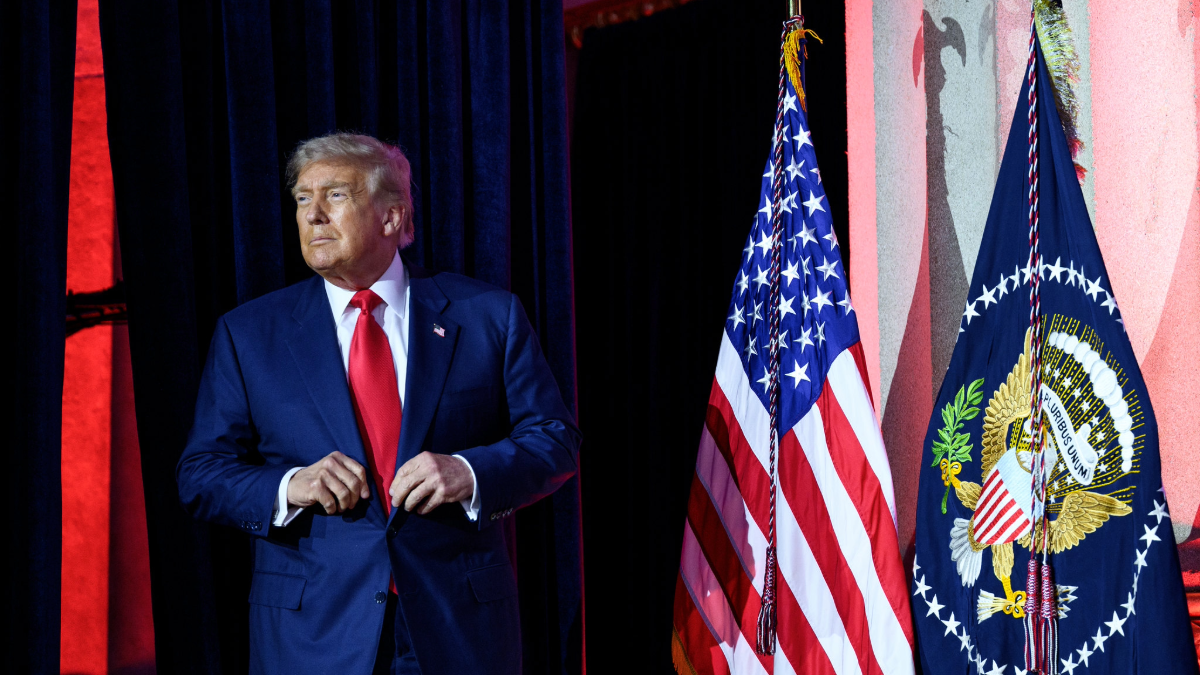Trump’s AI Strategy Is At War With Itself
Suresh Venkatasubramanian, Costa Samaras, Cole Donovan / Aug 7, 2025Suresh Venkatasubramanian previously served as Assistant Director for Science and Justice in the White House Office of Science and Technology Policy (OSTP), where he advised on AI policy and co-authored the Blueprint for an AI Bill of Rights. Costa Samaras previously served in OSTP as Principal Assistant Director for Energy and OSTP Chief Advisor for the Clean Energy Transition. Cole Donovan previously served as Assistant Director for International Science and Technology in OSTP and in international science and technology roles at the State Department and Office of Space Commerce.

President Donald Trump arrives to the White House AI Summit at Andrew W. Mellon Auditorium in Washington, D.C., Wednesday, July 23, 2025. (Official White House photo by Joyce N. Boghosian)
AI policy is hard. It cuts across sectors, jurisdictions, geography, and requires coherence across all parts of government. When we were working on AI policy in the Biden administration, we spent a lot of time talking to people across agencies, the public, and with each other to make sure we were pointing in the same direction.
The Trump administration’s new AI Action Plan attempts to do this, and if you don’t look too closely, or don’t track other administration policies, it has some ideas that seem promising on the surface. But when you get into the details—and policy is all details—you see a plan at war with itself and with this administration’s actions. And that’s only when this plan tries to make sense. The only parts of it that are coherent are the ones that display either a wilful lack of understanding of how AI (and the world) works, or worse—and more likely—represent a frightening power grab and muzzling of research by an administration that the tech sector should be very scared of.
Consider the plan’s focus on innovation, the first of its three pillars. It’s very important that we develop a robust framework to evaluate AI for reliability and performance, develop high-quality data sets to improve the use of AI in science, or lean into development of open source and open weight models that can be better evaluated than their closed counterparts. Everyone agrees that we need deeper investments in AI research and quality data sets, as well as improving AI education.
Once you dig even a little deeper, these ideas seem to be in direct contradiction to Trump administration actions thus far. The innovation-at-all-costs perspective as articulated by Vice President JD Vance at the Paris AI Action Summit ignores any concerns about AI safety and attempts to evaluate it. Indeed, the National Institute of Standards and Technology (NIST) is also being asked to strip out any considerations of AI bias, or misinformation (itself a safety concern) as well as climate change in the AI Risk Management Framework. And while there’s no doubt that quality data sets will improve our ability to develop models for help with scientific discovery, this comes against a backdrop of the systematic DOGE-enabled destruction of a number of critical government data sets that researchers have relied upon to answer questions in medicine and public health.
The second pillar of the administration’s AI Action Plan is about building for the age of AI: building up the electric grid, semiconductor manufacturing, secure data centers, and an AI workforce. The US needs all of these elements. The problem is that the administration's approach will not deliver what is needed because it focuses on the past instead of the future. The US will likely end up with higher costs, higher pollution, and less competitiveness.
The plan correctly focuses on electricity, which AI uses as an essential input. Through computations, electricity turns into value. As the AI capabilities grew over the last five years, US electricity demand started growing again for the first time in 15 years. This happened at the same time that growth from electrification of homes, vehicles, and manufacturing put more upward pressure on electricity demand—and prices. In the face of this new demand, the US should be enabling new electricity supplies to come online, and quickly. Solar, energy storage, and wind power are clean energy assets that can be quickly deployed to meet AI’s demands, and are the dominant sources of new energy capacity to get connected to the grid today. Unfortunately, the Trump administration’s One Big Beautiful Bill raises taxes on clean energy while Administration actions create new red tape making deployment of these energy sources more difficult and take longer. Reportedly, the Secretary of the Interior has to personally approve all permits for solar and wind power projects on federal lands. This doesn’t sound like a formula for getting new electricity supplies on the grid quickly.
Instead of enabling new clean energy to come online to support grid reliability, the AI Action Plan proposes speeding up the connection of new fossil power to the grid and recommends using “backup power sources to bolster grid reliability during peak demand.” This will result in higher costs and higher emissions. Companies will use diesel-burning backup generators (that are supposed to only run in an emergency), to instead sometimes make power for the grid. This will increase the air pollution that communities face while only serving as a band-aid to the electricity supply and price crisis. These generators are often not even grid-connected, doing nothing to reduce local energy prices. Clean energy can be deployed quickly and helps stabilize the grid during times of peak stress. While the AI Action Plan nods to the importance of advanced energy technologies like geothermal, advanced nuclear, and fusion, the other parts of the administration are in the process of slashing federal funding and capacity for R&D at the Department of Energy, National Science Foundation, and the Environmental Protection Agency (EPA). Taken together, this is a recipe for higher energy costs, slower growth, and less energy capacity to meet the needs of AI and the rest of society.
Finally, innovation requires cutting-edge science that comes from research—especially academic research. Whether it’s core research in the foundations of AI, the mathematical and scientific infrastructure to support AI systems, the broader sociotechnical research that makes sure the benefits of AI and AI education accrue to all. However, these technologies need federal investment to advance to sustainable market adoption, as well as sustained and enhanced federal R&D funding. All of these funding sources are under severe attack, not to mention the institutions that will perform this research, and severely compromise our ability to deliver in time to help the AI race.
If research is the currency of domestic innovation, then trust is a country’s primary currency on the world stage. This extends to countries’ willingness to buy American and use American. While it’s true that demand for AI products is growing internationally, so too is suspicion of technology companies whose products now touch every facet of our lives. Canadian consumers are already boycotting American products. The administration’s attacks on places like the European Union and Brazil over content moderation are only strengthening global anti-American sentiment.
Despite this posture, the third pillar of the Trump plan expects these countries to buy US products and limit Chinese influence in AI development. Within three days of the Action Plan’s release, Chinese Premier Li Qiang released a competing plan at the World Artificial Intelligence Conference. Unlike the American plan, China’s plan offered to share technology with developing countries and leaned into open source development, filling a void left by this administration’s isolationist policies. Why would other countries buy our stuff and take our side when the US government is publicly undermining them? And why would countries tighten their export controls when we’re relaxing ours (so that President Trump can get a meeting in Beijing with President Xi)?
Looking back to this AI Action Plan’s domestic problems, there’s also the backdoor moratorium and what the administration calls “woke AI” distractions. The AI Action plan calls for agencies to determine funding for states based on whether the “AI regulatory climate” in the state hinders the effectiveness of that funding, and also calls for federal procurement guidelines that require that companies certify that their AI models are “free from ideological bias” and “objective.”
This is not AI policy in any recognizable form. It’s more accurately a threat of punishment for states and companies that cannot find ways to please the administration. Both of these terms—“AI regulatory climate” and “free from ideological bias”—are too vague to mean anything other than “it is what I say it is.” When we were developing guidelines around algorithmic discrimination in the Biden administration, we spent days consulting with lawyers in the Department of Justice Civil Rights division to make sure the language we used conformed with core civil rights protections so that it was clear to model developers what protections they might want to install and when that would be sufficient. These guidelines are nothing but a way for the Trump administration to reward those who comply and punish those who don’t.
It is of even greater concern that rather than create an environment of free-flowing innovation, these provisions limit AI model developers to producing models that sycophantically parrot talking points of those in power. Imagine a world full of LLMs that all behave like Grok (which recently called itself “MechaHitler”). That’s the kind of innovation we are heading towards.
As the old saying goes, “reputations take a lifetime to build and only seconds to destroy.” The administration’s actions around the AI Action Plan undermine our research enterprise, our growing clean energy industry, and our trusted status in the world. All of these are crucial to the plan’s success. Reversing course will require addressing the concerns of the country’s people and its partners, humility in our actions, and leading by the power of example. Yet even if as a country we do those things, we fear it may be many years before the US rebuilds the trust and credibility that gave us strength and leadership on the world stage.
Authors


